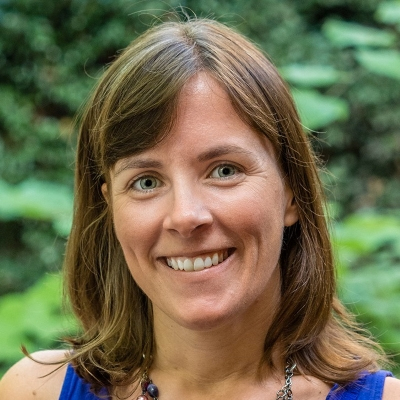New Designs for School
From Teacher to Teammate: Real-World Projects Challenge Students and Teachers Alike
Topics
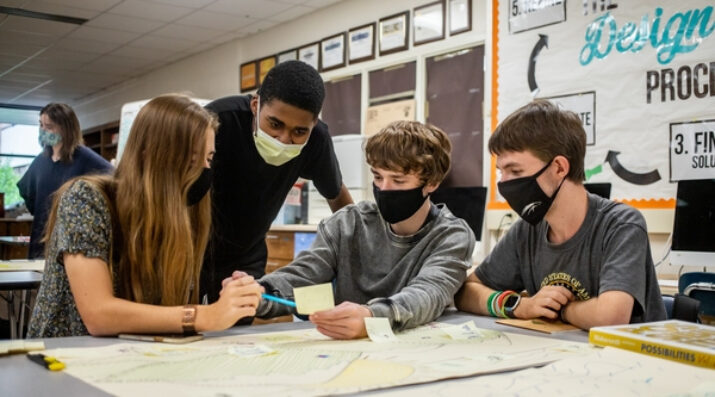
We’ve all had the experience of truly purposeful, authentic learning and know how valuable it is. Educators are taking the best of what we know about learning, student support, effective instruction, and interpersonal skill-building to completely reimagine schools so that students experience that kind of purposeful learning all day, every day.
Community-based projects are a game-changer in the classroom, when students learn to use design thinking to solve problems, address community needs, and make an impact... and teachers become partners in learning.
After 12 years of teaching, I thought I had mastered connecting curriculum to student interest. However, during the pandemic, the problem of student engagement became glaring as students struggled to find purpose. Faced with learning on their own, they encountered the daunting task of finding meaning in standards that were disconnected from “real life.”
While students struggled to find motivation and purpose, I also faced the need to rethink my view of teaching and learning. There were a lot of questions that ran through my mind. The main one that continued to resurface was, “What actually matters?” With shortened teaching time, on top of the disengagement, I encountered the formidable moment of figuring out the goal of my courses and what I truly wanted students to learn/know. For years, the county and the state have been telling teachers what matters most through the curriculums provided. This pandemic shined a light on the fact that the standards weren’t cutting it.
When I reflected on what my design courses had lost in the online transition, I realized that the community connections and design thinking that I had built in my first few years of teaching had vanished. Classes became flat and task driven, and my students couldn’t “think big” anymore because they didn’t have the space to do so. The new tech standards weren’t enough for my students, and they didn’t work for me either. Teaching a student how to click buttons in an ever-changing and evolving technology-filled world felt pointless and went against every virtue taught to me within my design degree. I needed more and so did they.
Apply Now! Bravely 2025-26
Apply by May 5, 2025 to Bravely reimagine student success! Get funding and a year of research-based supports from NGLC’s expert facilitators.
Learn More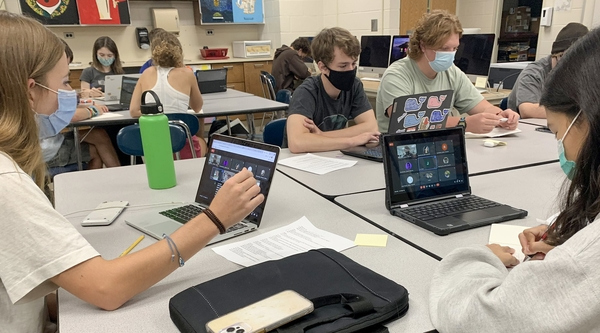
“What actually matters?” is a tough question to answer. Upon some reflection, I realized that I have two major goals within my classroom.
First, I want students to become proficient in the design programs so that they can create.
Second, I need students to understand how to use these skills to solve problems, address community needs, and thus, make an impact.
The base curriculum covered the first goal, but the second part was on me to create and develop.
A Design Thinking Classroom
The design process is a procedure with which everyone needs to become familiar in the 21st century and is a necessity to achieve my second goal. My graphic design degree from North Carolina State University taught me the importance of design thinking and its impact on creating change. As a teacher, this training is implemented within my classroom. I explain to students that no matter what subject area they are interested in, the process is applicable. You will always be solving problems and inventing solutions whether they are designed products, business plans, or vaccines; your life is about problem-solving and innovating. There are a lot of design processes out there, from simple to complex, but they all move you through the same base steps.
- Empathizing with the user/ Gathering information
- Defining the problem
- Ideating/ Finding solutions
- Creating and evaluating solutions: Sharing out and receiving critique
- Refining and adjusting those solutions

These steps were the guiding process in my classroom before the pandemic and needed to be reinstated at the forefront of my classroom as students returned to school this year. Rather than teaching the five step process to students as a discrete skill, I recognized the importance of integrating the five steps into every project and assignment, to teach through the five steps. Transforming a classroom to incorporate this type of thinking is complex and time consuming. It forced me to break away from the provided curriculum and enhance it. I had to carve out time within my classes for students to think deeply around problems, to debate, and to develop and express opinions.
For the first time in a long time I saw growth as students pulled away from a task-completion mindset and, instead, focused on seeking feedback and refining ideas. Allowing time for thought and exploration was key to moving students toward being problem-solvers. Students began to turn to each other for opinions and, instead of rejecting the other person’s thoughts, they sought to understand another viewpoint. When they fell short on a technical skill, they didn’t shut down. Instead, they asked for help from me or another student, searched on the internet for support, etc. Because the assignments were structured in a more open-ended manner, students were no longer worried about being seen as “right.” Instead, they focused on creating the best result possible for them at that time.

Building a creative thought process was only half the battle, though. I needed to connect students to the community to engage in purposeful ways. In the past, I have connected to community members that needed graphic design work done. I knew that my students responded better to real-world projects than any construct I could mimic. But as a teacher, I was overwhelmed by the time required to track down community members in need, connect them with students, and figure out the direction and goal of the project. I needed community connection to help my students build their purpose, but figuring out how to make that happen was a roadblock. Then Project Invent came along.
Project Invent would impact my classroom in ways that I did not understand immediately, challenging me as an educator while also providing structure and opportunities for my students. Project Invent was a tangible organization that took the design process I had been working so hard to embed in my classroom and connected it to problem-solving within the community. They were the bridge that I needed to make my second goal come to fruition.
Get the learner perspective on real-world projects from a former student in Ms. Luna’s class!
Rethinking Education: Prioritizing Creativity and People over Grades and Rubrics
Real-World Context Is Everything to a Student
My students need connection. I was inundated with statements like, “I am most excited about being able to apply design to group projects and work towards making an impact for someone,” and “getting to do something real.” Project Invent partnered us with two community members that matched our school’s magnet theme. We have a global health theme at our school that teachers are supposed to integrate into curriculum, and some students take part in a STEM Academy which focuses on sustainability. My community partners targeted both of these areas, one from the North Carolina Forestry Division and another with a son that struggled with microcephaly amongst other medical conditions.
In order for students to take full ownership, I handed the reins to them immediately. We reviewed some basic interview etiquette, students did some background research, and then we scheduled our first interview. My students met with the community partners and controlled the interactions from the start. The interviews brought a deeper engagement. I often work to mimic projects and requests they would receive in the workforce so my students are used to getting a ‘real’ project brief that I create for them. However, I have never before put them in front of someone and asked them to listen to everything that person has to say and attempt to deconstruct the client’s biggest needs. In this situation, they were tasked with figuring out what the client’s problems were, empathizing with them, and defining their direction of work. Meeting our clients was a game-changing experience for students. They left their interview sessions discussing every statement said, went back and analyzed the transcripts, and argued about what was most important and what should be the focus. Their passion bloomed before my eyes as these excited students became invested in the people sitting across from them.
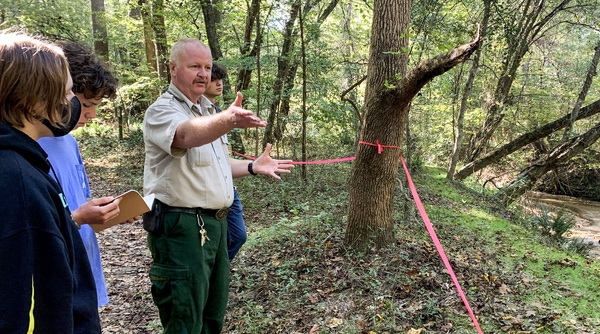
Visiting a Site Creates Opportunities to Learn and Understand
Visiting the site of a problem or seeing a situation in-person is essential for kids to "feel" what is going on. Encouraging students to venture out to a space or physically research and experiment with a problem is the key to better understanding. Students come up with more accurate solutions and/or develop new ways to look at things when they can experience the space or problem first hand. My students were sure their solution direction was the right way to go, until they had an opportunity to visit the site of concern. After walking the space, experiencing the different areas, and hearing more from the client, they agreed they’d have to pivot their ideas and throw out their plans. It turns out, they had not solved the most essential problems and they knew their plans weren’t accurate anymore. The feedback from their partner and the chance to immerse themselves into a situation made students aware of possibilities they had not imagined based on their own experiences.
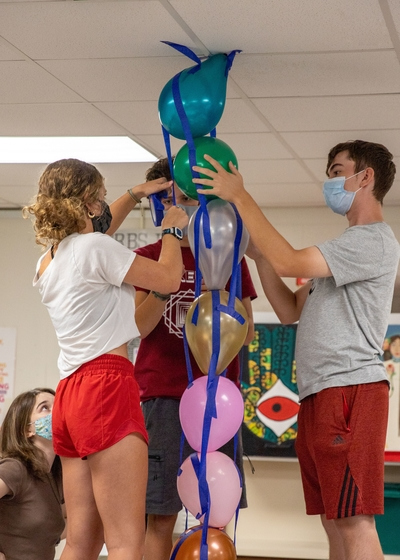
Team Assignments and Collaboration Support Change-Making
I wanted students to self-select the design challenges most interesting to them.Interviews, breakdowns, and problem analysis were done with all students in randomly assigned small groups as well as a whole class. This ensured a basic understanding of both clients for all and would foster a better creative environment as our class progressed through the year. If every student understood the problems at hand, every one could provide valuable feedback and be active supporters in the invention process. As research and problem definition progressed, students began to really gravitate toward one client over the other; natural separations started to form within the classroom.
Even with the class splitting, groups were still too large for each student to have an active voice. They worked through a variety of ideation charts as they narrowed their points of interest with the client, thus further dividing themselves into smaller cohorts. I also began surveying students around different skill sets to ensure that groups were balanced with knowledge/ability as much as possible. However, one student pointed out, “It’s more important that I am passionate about what I am working on and who I am working with than having a technically skilled team. I want to be invested in this.” His statement reminded me that the point of the teams was to push student-passion forward; I needed to be careful about balancing a team around skill and needed to focus more on dedication and client-based interest.
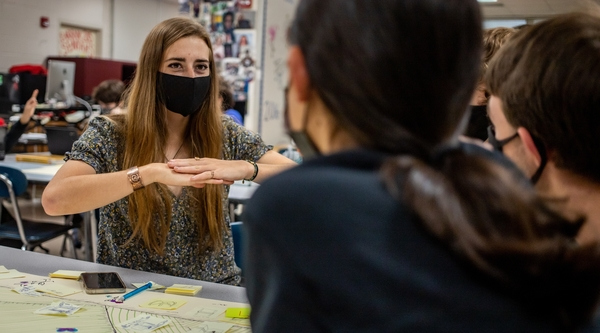
Community Engagement Can Fill the Knowledge/Skill Gap of the Teacher
“I don’t know how” might be the most common phrase uttered by students and myself this year. I vividly remember the point where I looked at my students and said we had hit the point where I no longer had the knowledge base to support them. I am a graphic designer. I like to make things look good and I enjoy the challenge of communication. When we hit questions around feasibility and the prototyping stage, I was way out of my league. I openly admitted this to my students. That moment was transformative as the playing field was leveled. My job was to support them and help them problem-solve. I couldn’t tell them what was right or wrong and, as students realized this, we entered a space where trial and error would lead to a lot of failure and, hopefully, some success. The rhythm of the class changed.
Already engaging with community members as clients, it occurred to me that I could use community members to support my students where my knowledge was scant. I sought help from teachers, friends, college students, and local businesses. Since virtual meetings are so prominent now, the challenge of getting students and professionals together was almost non-existent. It became a natural process: students would hit a question that we genuinely couldn’t answer, we’d debate about what type of person would be able to support us, and I would work alongside my magnet coordinator to find a professional that could help. Product developers could understand their idea and talk to students about feasibility, often giving them parts to look up or products to learn about. Engineers talked about intricate electronic concepts, pointing students to a type of relay or remote. Gardeners and landscapers discussed invasive species and methods of removal, directing us back to specific research articles and studies completed.
Honest and purposeful feedback is absolutely vital for students to know whether an idea is successful, possible, or should be pursued further. Real feedback from invested clients and business professionals encourages students’ refining and adjusting solutions for the benefit of the project. Without client and community insight, the initial design may be "good" but not fulfill all the essential needs. Since feedback came from multiple volunteers spanning different backgrounds, students were exposed to a variety of viewpoints. They learned how to sift through reviews and pull the most essential information. Designers need to take feedback as a gift of new possibilities, not a "put down" of their ideas.
Every conversation a student had, even when it was filled with critique, led to more energy and motivation. Students pivoted concepts, considered issues they hadn’t previously thought about, and had moments of confirmation that I couldn’t give them. Every time, they came back and asked for more. I realized that the engagement with outsiders filled the knowledge gap I faced while also giving the kids meaningful experience with experts in a variety of fields. The cool part was, they came back to me to share their excitement, their success, their questions and concerns. I was now a member of each team; instead of being the one with the answers, I was getting to be part of their support system. I was working alongside them to hypothesize and decide on their next steps as an equal, which so rarely happens in the classroom.
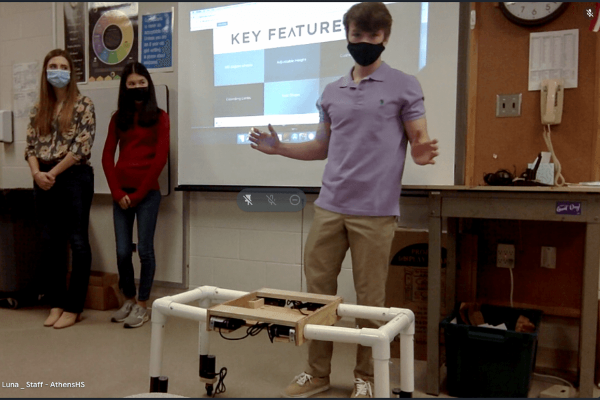
Local professionals want to work with students and, when asked to engage actively and not just as a speaker, they are as fulfilled as the kids. The experience benefits everyone involved. Making time for those interactions is key to keeping students engaged in their work. ‘Rejuvenating’ was the word many community members used. The students brought new hope and excitement to their lives. One professional said, “Your students’ passion is electrifying. I am so impressed with their concepts and work. They will change the world and have the ability to do that because of the opportunities you’re providing them.” His excitement reminded me of what many professionals have said over the years, “Students are the future and I want to work with them and inspire them to create.”
Student Success Is So Much More than Test Scores
As a teacher, my job has been consistently broken down into teaching students standards and technical skills. Because of a need to ‘test’ students to prove their success, my curriculum has lost the applicability, creative thinking, and all of the upper-level verbs in Bloom’s Taxonomy. I’ve come to believe that focusing on new high-tech skills is an archaic choice. The world is continuously evolving and shifting; my job is not to teach a skill that will be outdated in a year to come, but use the skills as a means of production and creation.
With this mindset, students learn by necessity and naturally gain ability as they apply themselves to larger tasks. It is not going to be equal. Every student will not develop success in the same area. Some students end up gaining coding knowledge, others focus on design, some find out their success is in presentation, but all grow in areas that interest them and help direct them in future career choices. Amongst individual accomplishment, there is also a level of success that comes from having to work closely in a team. They’ve learned how to hold each other accountable, how to manage peers and time, and how to celebrate each small victory.
I have enhanced the learning experience to wrap around a student and their natural abilities by building creative spaces, community connection, and providing opportunities in which everyone learns from each other. Beyond the student, I have enhanced my teaching experience, challenging myself to be comfortable with students working on a variety of skills, with non-traditional ways to measure success, and with not always having the control over learning direction. The environment that forms from client-driven projects and community engagement is life-giving to community members, teachers, and students alike.
The Portrait of a Graduate in Practice
New from NGLC! The outcomes that Elizabeth Luna sees from real-world projects are often the competencies expressed in a school or district's graduate portrait. Find out how portraits are inspiring system-wide change where this kind of teaching and learning can thrive.
Learn MoreAll photos courtesy of the author.

